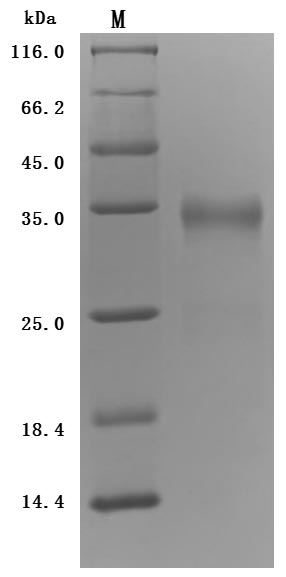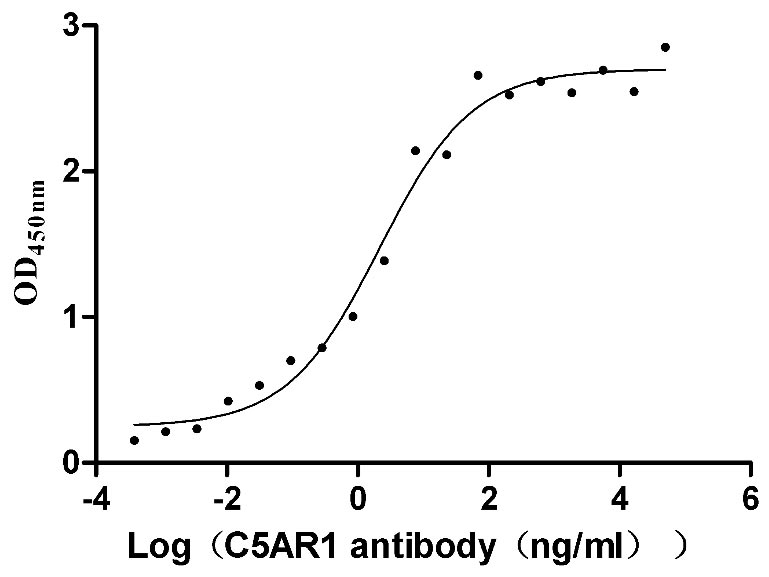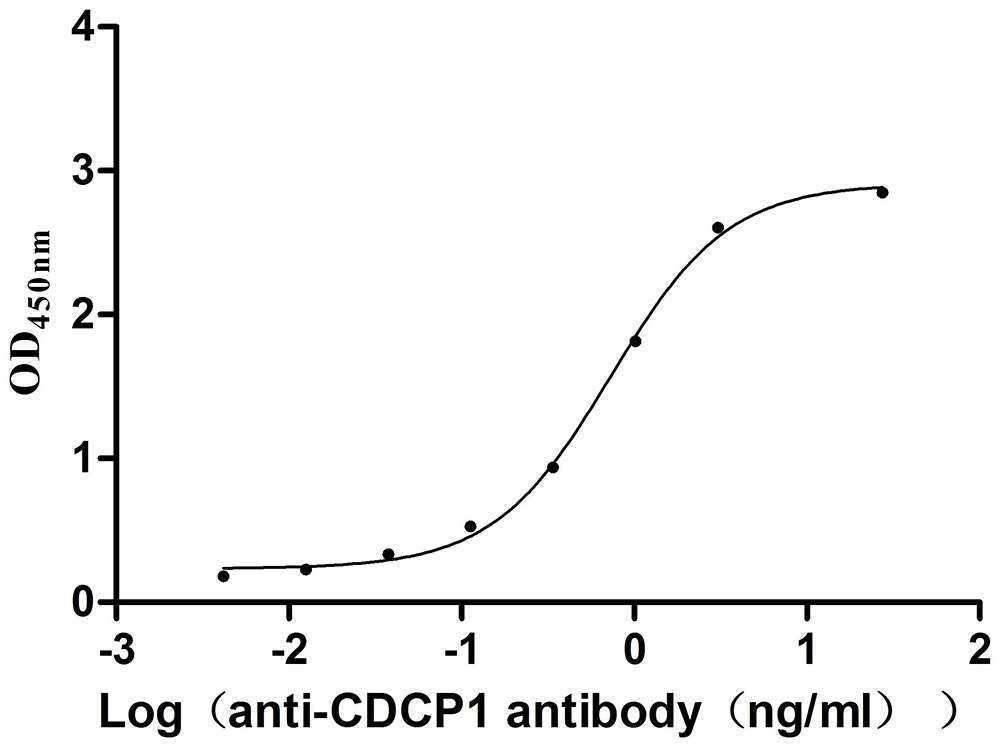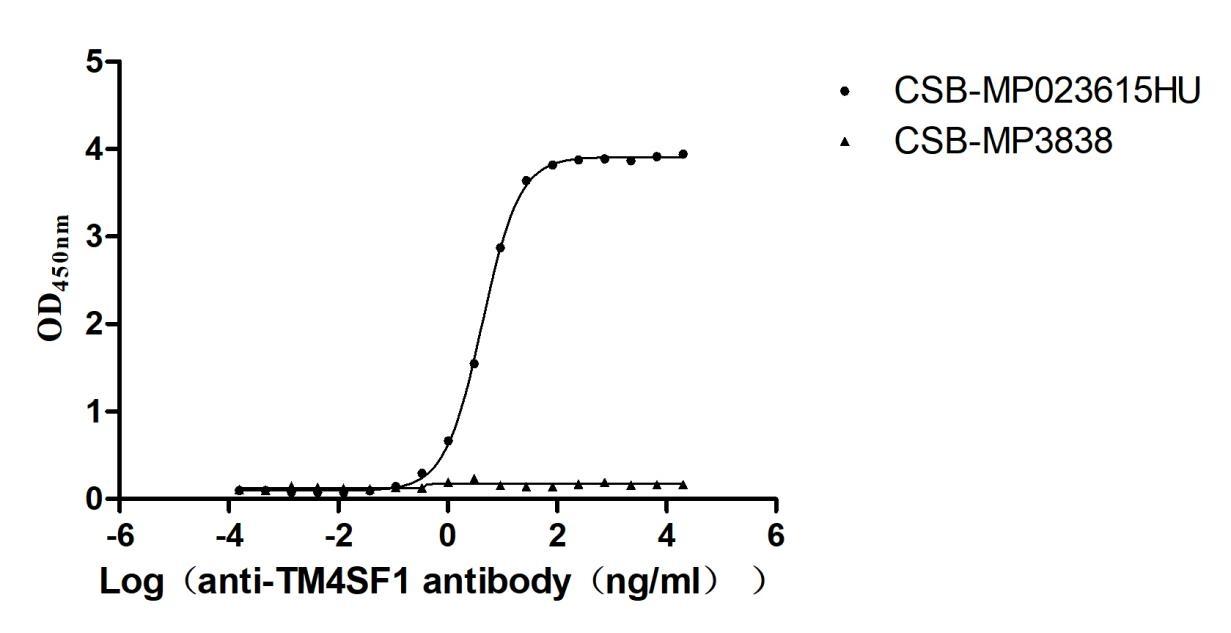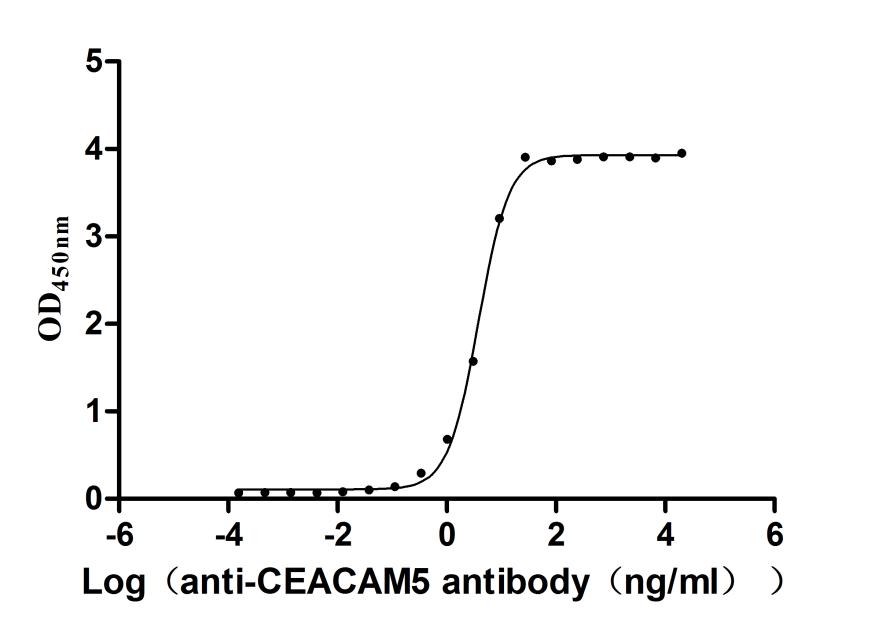Recombinant Human Prolactin receptor (PRLR), partial (Active)
In Stock-
中文名稱:人PRLR重組蛋白
-
貨號:CSB-MP018727HU1d7
-
規(guī)格:¥1368
-
圖片:
-
(Tris-Glycine gel) Discontinuous SDS-PAGE (reduced) with 5% enrichment gel and 15% separation gel.
-
Activity
Measured by its binding ability in a functional ELISA. Immobilized Human PRLR at 2 μg/ml can bind Anti-PRLR recombinant antibody (CSB-RA018727A0HU), the EC50 is 126.8-171.9 ng/mL. Biological Activity Assay
-
-
其他:
產(chǎn)品詳情
-
純度:Greater than 95% as determined by SDS-PAGE.
-
內(nèi)毒素:Less than 1.0 EU/ug as determined by LAL method.
-
生物活性:Measured by its binding ability in a functional ELISA. Immobilized Human PRLR at 2 μg/mL can bind Anti-PRLR recombinant antibody (CSB-RA018727A0HU), the EC50 is 126.8-171.9 ng/mL.
-
基因名:
-
Uniprot No.:
-
別名:PRLR; Prolactin receptor; PRL-R
-
分子結(jié)構(gòu):
-
種屬:Homo sapiens (Human)
-
蛋白長度:Partial
-
來源:Mammalian cell
-
分子量:27.2 kDa
-
表達(dá)區(qū)域:25-234aa
-
氨基酸序列QLPPGKPEIFKCRSPNKETFTCWWRPGTDGGLPTNYSLTYHREGETLMHECPDYITGGPNSCHFGKQYTSMWRTYIMMVNATNQMGSSFSDELYVDVTYIVQPDPPLELAVEVKQPEDRKPYLWIKWSPPTLIDLKTGWFTLLYEIRLKPEKAAEWEIHFAGQQTEFKILSLHPGQKYLVQVRCKPDHGYWSAWSPATFIQIPSDFTMND
-
蛋白標(biāo)簽:C-terminal 10xHis-tagged
-
產(chǎn)品提供形式:Lyophilized powder
Note: We will preferentially ship the format that we have in stock, however, if you have any special requirement for the format, please remark your requirement when placing the order, we will prepare according to your demand. -
緩沖液:Lyophilized from a 0.2 μm filtered 20 mM Tris-HCl, 0.5 M NaCl, 6% Trehalose, pH 8.0
-
復(fù)溶:We recommend that this vial be briefly centrifuged prior to opening to bring the contents to the bottom. Please reconstitute protein in deionized sterile water to a concentration of 0.1-1.0 mg/mL.We recommend to add 5-50% of glycerol (final concentration) and aliquot for long-term storage at -20°C/-80°C. Our default final concentration of glycerol is 50%. Customers could use it as reference.
-
儲(chǔ)存條件:Store at -20°C/-80°C upon receipt, aliquoting is necessary for mutiple use. Avoid repeated freeze-thaw cycles.
-
保質(zhì)期:The shelf life is related to many factors, storage state, buffer ingredients, storage temperature and the stability of the protein itself.
Generally, the shelf life of liquid form is 6 months at -20°C/-80°C. The shelf life of lyophilized form is 12 months at -20°C/-80°C. -
貨期:Basically, we can dispatch the products out in 3-7 working days after receiving your orders. Delivery time may differ from different purchasing way or location, please kindly consult your local distributors for specific delivery time.
-
注意事項(xiàng):Repeated freezing and thawing is not recommended. Store working aliquots at 4°C for up to one week.
-
產(chǎn)品描述:
CUSABIO's recombinant human PRLR (25-234aa) is an active protein expressed in mammalian cells. It carries a 10xHis-tag at the C-terminus. Its purity is up to 95% measured by SDS-PAGE. Its endotoxin and activity have been accessed.
PRLR is expressed on mammary gland cells, pancreatic β-cells, adipocytes, and immune cells. Upon binding to the PRL, PRLR occurs dimerization, activating the JAK2-STAT5-SOCS, PI3K, and MAPK signaling pathways thus leading to increased survival, proliferation, and differentiation of these cells. PRLR is involved in reproduction, islet differentiation, regulation of fat stores, and immune responses. PRL-PRLR interactions are essential for the development and differentiation of the normal breast. Abnormal PRL-PRLR activity has been related to the development of numerous cancers, including breast cancer. Enhanced PRLR expression and high circulating concentrations of PRL have been related to an increased risk of tumor progression and invasion.
-
Datasheet & COA:Please contact us to get it.
相關(guān)產(chǎn)品
靶點(diǎn)詳情
-
功能:This is a receptor for the anterior pituitary hormone prolactin (PRL). Acts as a prosurvival factor for spermatozoa by inhibiting sperm capacitation through suppression of SRC kinase activation and stimulation of AKT. Isoform 4 is unable to transduce prolactin signaling. Isoform 6 is unable to transduce prolactin signaling.
-
基因功能參考文獻(xiàn):
- In a replication study of the association between the prolactin receptor gene intron C/T polymorphism (rs37389) and recurrent miscarriage, no association was found. PMID: 28980840
- Low PRLR expression is associated with Triple Negative Breast Cancer. PMID: 27480353
- These results illustrate promising antitumor activity against PRLR-positive breast cancer xenografts and support the evaluation of anti-PRLR antibody-drug conjugate as potential therapeutic agents in breast cancer. PMID: 28377489
- Prl receptor is expressed at different levels in the majority of glioblastoma multiforme tumors. Prolactin stimulation resulted in increased STAT5 phosphorylation and increased cellular invasion. PMID: 27788487
- PRLRI146L and PRLRI176V variants are not associated with breast cancer or multiple breast fibroadenomas risk. PMID: 27575941
- This study identified 4 PRLR variations (p.Ile76Val, p.Ile146Leu, p.Glu108Lys and p.Glu554Gln) in 16 Sporadic Prolactinoma in Humans. PMID: 26641246
- results highlight PRLR as an independent predictor of favorable prognosis in human breast cancer PMID: 26317306
- Two markers for the PRL peptide gene and three markers for the prolactin receptor (PRLR) gene were genotyped. PMID: 26513615
- The prolactin receptor is constitutively expressed on regulatory T and effector T cells in systemic lupus erythematosus patients, and this expression is higher than in healthy individuals. PMID: 26844452
- There is a possible role for PRLR in the progression of cervical cancer. PMID: 24990775
- Study shows that position 146 plays a central role in directing intrinsic properties of the PRLR, including extracellular domain folding, PRL-responsiveness, and ligand-independent activity of the receptor. PMID: 25524456
- Data suggest that (1) cell membrane/lipid bilayer binding of PRLR and (2) tyrosine phosphorylation of PRLR intracellular domain are independent. PMID: 25846210
- long PRLR plays an important role in breast cancer metastasis. PMID: 26095602
- a residue quartet in the extracellular membrane proximal domain of the homodimeric cytokine receptor prolactin receptor is a key regulator of intracellular signaling discrimination PMID: 25784554
- PRL induced transient signaling pathways in neurons and modulated ion channels. [review] PMID: 24758841
- exposure to prolactin increases TNF-alpha release from CD14(+) monocytes of rheumatoid arthritis patients, which can be abolished by PRLR gene silencing or treating with MAPK inhibitor. PMID: 24997655
- High MFAB expression is associated with testicular germ cell tumor and glioblastomas. PMID: 24391856
- Negative/low expression is associated with poorly differentiated and larger breast tumors in Poland PMID: 24249584
- Major changes in prolactin receptor conformation and dimerization affinity are triggered by single mutations in critical regions of D1. PMID: 24735798
- PRL-R attenuation post-transcriptionally increased ZnT2 abundance and redistributed intracellular Zn pools into lysosomes and mitochondria. PMID: 24333596
- Hypertrimethylation on H3K27 of the p53 gene promoter region due to elevated expression of DeltaS2 PRLR by alternative splicing of the pre-mRNA in its full-length form might serve as a new mechanism underlying prostate cancer PMID: 24032713
- Data suggest that signal transduction via prolactin and prolactin receptor plays role in trophoblast cell migration and invasion; PRLR is expressed by extravillous cytotrophoblasts and first-trimester placental bed tissue. PMID: 23849393
- PRL-induced transient signaling in sensory neurons is governed by PI3K or PKCepsilon, mediated via the PRLR-S isoform, and transient effects mediated by PRLR-S are inhibited by presence of PRLR-L in these cells. PMID: 24142695
- SNPs of the PRLR gene 5' UTR and promoter region are associated with increased risk for gestational diabetes in a population of Chilean subjects. PMID: 23651351
- Thus, the familial hyperprolactinemia appears to be due to a germline, loss-of-function mutation in PRLR, resulting in prolactin insensitivity. PMID: 24195502
- Results demonstrate a novel function for hepatic PRLR in the regulation of insulin sensitivity and provide important insights concerning the nutritional regulation of PRLR expression. PMID: 23775766
- Our data suggest that prolactin receptor presence meaningfully affects growth hormone receptor use in breast cancer cells. PMID: 23192981
- The prolactin receptor transactivation domain is associated with steroid hormone receptor expression and malignant progression of breast cancer PMID: 23159947
- Our results indicate no significant association of prolactin and PRLR polymorphisms with clozapine response, tardive dyskinesia diagnosis or its severity in patients with schizophrenia PMID: 21305610
- can be activated by three sequence-diverse human hormones: prolactin, GH, and placental lactogen [review] PMID: 22577091
- PRLr isoforms expression and PRLr subcellular localisation are altered in parathyroid tumours PMID: 22606260
- The structure of the human prolactin receptor reveals a structural link between the WSXWS motif, hormone binding, and receptor dimerization and we propose it as a general mechanism for class 1 receptor activation. PMID: 22325776
- PRL signaling through the long form prolactin receptor causes reduced fatty acid oxidation, increased lipid storage, glucose intolerance, and obesity. PMID: 21989556
- data provide limited support for an association between common variations in PRLR and breast cancer risk PMID: 21470416
- The association of the PRLr with HMGN2 enables Stat5a-responsive promoter binding, thus facilitating transcriptional activation and promoting anchorage-independent growth. PMID: 21816901
- Our study suggests the prolactin receptor gene is a molecular target that may be important in the pathogenesis and progression of lobular neoplasia PMID: 20658264
- Enhanced complex formation of ERalpha dimer with SP1 and C/EBPbeta by E2 has an essential role in the transcriptional activation of the hPRLR gene. PMID: 21670145
- Data show that cells expressing higher long:short PRLR ratios had increased growth, survival and migration in response to PRL and suggest that PRLR antagonists may be therapeutically beneficial in ovarian cancer. PMID: 21775057
- Endogenous GH receptor(GHR) and PRLR associate, possibly as a GHR-PRLR heterodimer, in human breast cancer cells and GH signaling in these cells is largely mediated by the PRLR in the context of both PRLR-PRLR homodimers and GHR-PRLR heterodimers. PMID: 21310852
- The positive correlations in positivity rate between the PRL-R and ER/PR expressions are found only in CerbB-2 positive patients with breast cancer. PMID: 20335148
- SIRPalpha modulates PRL receptor-associated signaling as a function of integrin occupancy by mediating integrin-PRL receptor cross-talk and contributing to breast cancer biology. PMID: 20826546
- both Zn(2+) and human PRLr binding influence human PRL conformers in an interdependent fashion PMID: 21510945
- Functional impact of manipulation on the relative orientation of human prolactin receptor domains. PMID: 21591677
- Progesterone induces expression of the prolactin receptor gene through cooperative action of Sp1 and C/EBP transcription factors PMID: 21238538
- Rabbit antibodies have high titer and could specifically recognize each isoform of PRLR in breast cancer cell lines and human breast carcinoma biopsies. PMID: 21144038
- Prolactin receptor signaling contributes to the local inflammatory response within the atherosclerotic plaque and thus to atherogenesis. PMID: 21068074
- Blockade of the PRLR represents a novel treatment for patients with advanced breast or prostate cancer with limited therapeutic options. PMID: 20846877
- acetylation and deacetylation provide the rheostat-like regulation for the cytokine receptor PRLR in its cytoplasmic loop dimerization and subsequent STAT5 activation PMID: 20962278
- This study allowed to visualize for the first time the loop L5 spanning PRLR2 residues Thr133-Phe140, revealing its central implication for the three intermolecular interfaces of the 1:2 complex between natural prolactin and two PRLR chains. PMID: 20875426
- prolactin receptor expression is common in colorectal cancer PMID: 20453834
顯示更多
收起更多
-
相關(guān)疾?。?/div>Multiple fibroadenomas of the breast (MFAB); Hyperprolactinemia (HPRL)亞細(xì)胞定位:Membrane; Single-pass type I membrane protein.; [Isoform 7]: Secreted.蛋白家族:Type I cytokine receptor family, Type 1 subfamily組織特異性:Expressed in breast, placenta, kidney, liver and pancreas.數(shù)據(jù)庫鏈接:
Most popular with customers
-
Recombinant Human C5a anaphylatoxin chemotactic receptor 1 (C5AR1)-VLPs (Active)
Express system: Mammalian cell
Species: Homo sapiens (Human)
-
Recombinant Mouse CUB domain-containing protein 1 (Cdcp1), partial (Active)
Express system: Mammalian cell
Species: Mus musculus (Mouse)
-
Recombinant Human Transmembrane 4 L6 family member 1(TM4SF1)-VLPs (Active)
Express system: Mammalian cell
Species: Homo sapiens (Human)
-
Recombinant Macaca fascicularis Transmembrane 4 L6 family member 1 (TM4SF1)-VLPs (Active)
Express system: Mammalian cell
Species: Macaca fascicularis (Crab-eating macaque) (Cynomolgus monkey)
-
Express system: Mammalian cell
Species: Macaca mulatta (Rhesus macaque)

